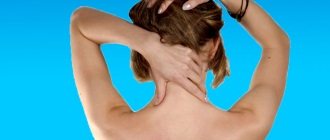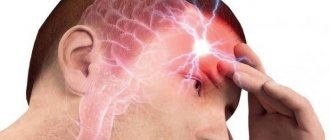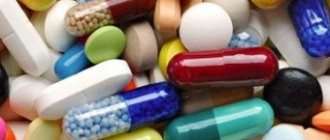Psychovegetative syndrome
It is a set of syndromes caused by disturbances in the mechanisms of autonomic regulation. The list of symptoms is quite impressive, but the most common are fluctuations in blood pressure, pulse and respiration rates, disturbances in thermoregulation (low-grade fever, decreased body temperature), muscle tone, nausea, vomiting, constipation, diarrhea, urinary retention, hyperhidrosis, dry mouth, hypersalivation, tearfulness, mydriasis, exophthalmos. Patients often complain of suffocation, a feeling of shortness of breath, a feeling of lack of air, and heart rhythm disturbances. Their anxiety is also associated with a feeling of heaviness in the epigastric region, a feeling of fullness in the stomach, flatulence, and belching.
| | In order to determine psychovegetative syndrome, it is necessary to undergo diagnostics |
Autonomic disorders can be diffuse, as well as local: cardioneurosis, angioneurosis, hyperventilation syndrome, irritable stomach, intestinal syndromes, etc. These are the so-called organ neuroses.
Autonomic disorders can be permanent, but often, especially at the beginning of the disease, they occur in the form of paroxysms that last up to two to three hours or more. Such attacks are sometimes identified with panic attacks, which requires solid evidence. The clinical structure of the psychovegetative syndrome may reflect the predominance of sympathetic tone (tachycardia, tendency to arterial hypertension, atonic constipation, mydriasis, exophthalmos, low-grade fever, dry mouth, hyperhidrosis) - a phenomenon of ergotrophic adjustment. In other cases, vagoinsular innervation dominates: nausea, vomiting, loose and frequent stools, rapid diuresis, arterial hypotension, hypersalivation, hypothermia, bradycardia, a feeling of suffocation - the phenomenon of trophotrophic adjustment. Mixed, amphitonic states are often encountered.
In child psychopathology, the term neuropathic syndrome is used, which means not only autonomic disorders, but also disorders of general activity, sleep, thermoregulation, appetite, regurgitation, vomiting, mood disorders, and physical development (hypotrophy). Neuropathic syndrome in children aged 2–3 years can manifest itself as affective respiratory attacks. Children, according to the stories of relatives, “roll up” and “get into trouble.” During crying, spasm of the laryngeal muscles, respiratory arrest, and asphyxia occur. The skin turns blue, consciousness darkens, and tonic convulsions develop. Catamnesis of children with affective-respiratory convulsions, as well as febrile seizures, indicates that a significant proportion of patients subsequently experience epilepsy. Neuropathic syndrome is considered typical for children under three years of age suffering from various diseases.
Psychovegetative syndrome is a nonspecific disorder.
It occurs in all mental illnesses; in the early stages of development it can be their main manifestation. Back to contents
Vegetative-vascular dystonia (VSD) - symptoms and treatment
All therapeutic measures for VSD include an impact on etiological factors and pathogenesis links, as well as general strengthening measures.
The impact on the causes of the disease is the desire to normalize lifestyle and eliminate the influence of pathogenic factors on the body.
Which doctor should I contact?
If symptoms of autonomic dysfunction of the nervous system appear, you should consult a neurologist.
Treatment of VSD, based on its pathogenesis , involves:
- normalization of cortical-hypothalamic and hypothalamic-visceral connections with the help of sedatives, tranquilizers, antidepressants and minor neuroleptics [10];
- reducing the activity of the sympathetic-adrenal system and reducing the clinical effects of hypercatecholaminemia through the use of beta-blockers.
When normalizing the afferent connections of the hypothalamus, it is preferable to use high-potential benzodiazepines (alprazolam, lorazepam, phenazepam), but only for a short course, and only to relieve “acute anxiety”, since a dependence syndrome quickly forms, and with prolonged use a withdrawal syndrome may occur. Phenazepam is also practical due to its lower toxicity (2.5 times less toxic than diazepam). Of the antidepressants in modern practice, selective serotonin and norepinephrine reuptake inhibitors (SNRIs) are more often used, since it is the lack of these neurotransmitters that causes the development of psycho-vegetative disorders [19]. Of the “small” antipsychotics, sonapax (thioridazine), eglonil (sulpiride) and teraligen (alimemazine) have found their use in neurological practice, since, having an “antipsychotic” effect, they are not accompanied by pronounced side effects of “larger neuroleptics” - extrapyramidal syndrome, hypersalivation and others [3].
Also, when approaching the treatment of vegetative-vascular dystonia from the point of view of pathogenesis, to correct neurotransmitter disorders, it is necessary to use drugs that restore cerebral metabolism:
- nootropics (glycine, phenibut);
- vitamin preparations - B vitamins (most often in medical practice complex forms are used - combilipen and milgamma - the main participants in the transmission of nerve impulses and myelin synthesis), as well as vitamins with antioxidant effects, especially A, E, C [9];
- ascorbic acid - activates redox reactions, increases the adaptive capabilities of the body [6][14].
To normalize metabolism, metabolic drugs (riboxin, mildronate) are actively used, which also have a microcirculatory, antihypoxic effect, normalizing glucose metabolism and oxygen transport [5].
General restorative measures for VSD include the elimination of alcohol, nicotine, coffee, a healthy diet, normalization of sleep, exercise therapy (physical therapy), and sanatorium-resort treatment [5]. Therapeutic massage, reflexology and water treatments also have a positive effect. The choice of physiotherapeutic treatment is influenced by the type of VSD: electrophoresis with calcium, mesatone and caffeine for vagotonia, electrophoresis with papaverine, aminophylline, bromine and magnesium for sympathicotonia [12].
psychotherapy is also very important in the treatment of VSD , during which the patient is explained the nature of the disease, is convinced that the disease is not life-threatening and has a favorable outcome, and skills are developed to control the psychosomatic manifestations of the disease and adequately respond to them [3 ].
The domestic drug Mexidol (ethylmethylhydroxypyridine succinate) also occupies a strong position in the complex treatment of VSD due to its antioxidant, microcirculatory, metabolic and, importantly, anxiolytic properties. By modulating the activity of receptor complexes, it preserves the structural and functional organization of biomembranes, transports neurotransmitters and improves synaptic transmission [14].
Recently, neurotrophics - cereton (choline alfoscerate), cortexin and cerebrolysin - have been very actively used in the practice of neurologists in the correction of autonomic disorders to strengthen the neurointegrative functional connections of various parts of the nervous system with each other and with underlying organ systems [3].
If cardiovascular syndrome predominates in the VSD clinic, in complex therapy with beta blockers for tachycardias and extrasystoles, potassium and magnesium preparations are used - asparkam (Panagin) and magne B6 (Magnelis) [14]. For vagotonia, use calcium supplements [4].
If headaches, weakness, dizziness and other cerebrovascular disorders against the background of sympathicotonia are expressed during VSD, then vasodilators (for example, myotropic antispasmodics) and vasocorrectors with a vasodilating effect (Cavinton, pentoxifylline) are used, which not only improve cerebral circulation, but also cerebral metabolism by improving oxygen transport, reducing hypoxia and glucose processing [3][9][14]. If cerebrovascular disorders occur within the framework of parasympathicotonia with a decrease in blood pressure, then drugs that stimulate vascular tone (vasobral) are more preferable. Nootropics can be used for the same purpose, as they stimulate the cardiovascular center of the nervous system.
In the case of intracranial hypertension syndrome, which is most often represented in VSD by functional cerebrospinal fluid-dynamic disorders, mild dehydration therapy (acetazolamide, furosemide in combination with potassium supplements) will contribute to improvement. Long-term use of diuretic herbs is also recommended [9].
In case of VSD, chronic foci of infection are treated with concomitant strengthening of the immune system using various immunostimulants (immunal, wobenzym, polyoxidonium) [3].
Causes
Psychovegetative disorders are often diagnosed in children of the older age group, as well as in adolescents and young adults. In more rare cases, the disease appears in people over 40 years of age. Neurocirculatory dystonia most often develops in young people. This is primarily due to the slow development of the neuroendocrine system in a young body, as well as the inconsistency between physical development and the functioning of the endocrine system.
Psychovegetative syndrome manifests itself under the influence of hereditary factors, constitutional characteristics, damage to the nervous system of an organic nature, somatic and mental disorders. Symptoms of the disease also appear due to hormonal changes in the body, psychophysiological changes (we are talking about stress - acute and chronic), psychosomatic diseases (heart disease, hypertension, bronchial asthma, etc.), diseases of the nervous system, some occupational diseases, mental disorders and neuroses .
All the described factors contribute to the manifestation of vegetative dystonia. If the disease is not treated in a timely manner, it may be complicated by the manifestation of panic attacks .
Autonomic dysfunction often occurs as a consequence of organic diseases of the brain, as well as in the presence of damage to the peripheral nervous system . But one of the most common causes of autonomic disorders is the process of endocrine changes in the human body during adolescence, as well as in women during menopause. A separate form is psychophysiological vegetative dystonia, which manifests itself in humans as a consequence of stress, severe physical strain, overwork , and neurotic disorders.
Prevention
As a preventive measure, it is important to use all the measures described above aimed at normalizing a person’s lifestyle. In addition, special attention should be paid to rest and sleep patterns. A person should sleep at least 8 hours every day.
An important factor is the correct approach to the daily diet. All meals in the diet should be high in vitamins and minerals. At the same time, it is better not to consume foods that excite the nervous system. We are talking about coffee, tea, chocolate, spices, smoked meats, and pickles.
In addition, doctors strongly recommend trying to receive as many positive emotions as possible and strive for a positive perception of life in general.
Diagnostics
A diagnosis of “vegetative dystonia” (psychovegetative syndrome, autonomic neurosis) can only be made if a comprehensive examination is carried out. Initially, it is necessary to exclude all somatic diseases that could provoke the manifestation of certain symptoms. It is especially important to do this if there are only violations in the operation of one of the systems.
To conduct a high-quality diagnosis, consultations with several doctors - specialists in different fields - are often necessary. Interviewing the patient is very important. The specialist needs to ask the patient in detail about his feelings and learn in detail about the subtleties of all manifestations.
During the examination, if psychovegetative syndrome is suspected, an electrocardiogram, MRI and computed tomography, and vascular Dopplerography are often prescribed. Treatment is prescribed on an individual basis, taking into account all the characteristics of the manifestations of the disease.
Panic attack in a dream
A separate type of disorder are nighttime panic attacks. Typical symptoms occur during periods of going to bed, accompanied by the following additional signs:
- unexplained awakening;
- shackling fear, horror;
- sudden change in body temperature;
- suffocation;
- disorientation;
- cold sweat;
- gastrointestinal disorders and/or involuntary urination;
- short-term paralysis of the body or some part.
After awakening, the symptoms slowly pass, leaving behind traces of fear and confusion. When a person realizes what happened, it becomes more difficult to fall asleep again. The primary attack can be falsely mistaken for a somatic disease - acute coronary syndrome, appendicitis, kidney damage.







